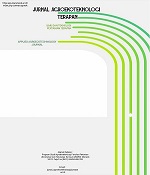Manufacturing And Technical Testing Of Household-Scale Gasification System Stoves Made From Raw Coconut Husk
DOI:
https://doi.org/10.35791/jat.v4i1.45294Abstract
The coconut husk is the outermost part of the coconut fruit that covers the coconut shell whereas one coconut contains 35% husk. In several areas, including in North Sulawesi, a lot of coconut husk is still being thrown away or left in the garden. Coconut husk has a potentially utilized energy capacity. For this reason, the idea arose to make a stove for energy utilization from coconut husk waste with a gasification system. The purpose of this study was to design and technically test a household-scale coconut husk stove with a gasification system. The research method was carried out by design and experimental testing, then the resulting data were analyzed descriptively. In this study, two types of stoves were designed and manufactured which were practical for application on a household scale using a gasification system made from coconut coir. The first stove that uses an air blower can reach a temperature of 740 ℃ and is tested with 1.5 liters of water, so the water can boil for 9 minutes. The second stove, which does not use an air blower, can boil 1.5 liters of water for 11 minutes at a temperature of 608℃. Both stoves have a waiting time to produce gas that is not much different, which is about 3 minutes with an initial fuel mass of 300 g. The results of economic calculations show that the cost of making this stove is relatively cheap and easy to maintain. However, the raw material for coconut coir runs out quickly and requires several replenishments of raw materials.
Keywords: Stove, household scale, gasification, coconut husk.
Abstrak
Sabut kelapa merupakan bagian terluar buah kelapa yang membungkus tempurung kelapa dimana dalam satu butir buah kelapa mengandung 35% sabut. Di beberapa daerah termasuk di Sulawesi Utara, sabut kelapa masih banyak yang dibuang atau dibiarkan saja di kebun. Sabut kelapa mempunyai kapasitas energi yang potensial dimanfaatkan. Untuk itulah timbul ide untuk membuat kompor sebagai pengganti kompor untuk pemanfaatan energi dari limbah sabut kelapa ini dengan sistem gasifikasi. Tujuan penelitian ini adalah membuat rancangan dan uji teknis kompor sabut kelapa skala rumah tangga dengan sistem gasifikasi. Metode penelitian dilakukan dengan pembuatan dan uji teknis alat secara eksperimental, kemudian data yang dihasilkan di analisis secara deskriptif. Dalam penelitian ini di buat dua tipe kompor yang diharapkan dapat diaplikasikan pada skala rumah tangga dengan menggunakan sistem gasifikasi berbahan baku sabut kelapa. Kompor yang pertama yang menggunakan penghembus udara dapat mencapai suhu 740℃ dan uji coba dengan air 1,5 liter, maka air tersebut dapat mendidih selama 9 menit. Kompor yang kedua, yang tidak menggunakan penghembus udara dapat mendidihkan air 1,5 liter selama 11 menit dengan suhu mencapai 608℃. Kedua kompor mempunyai waktu tunggu untuk menghasilkan gas tidak berbeda jauh, yaitu sekitar 3 menit dengan massa bahan bakar awal 300 g. Hasil perhitungan ekonomi menunjukkan bahwa biaya pembuatan kompor ini relatif murah dan mudah pemeliharaannya. Akan tetapi bahan baku sabut kelapa cepat habis dan memerlukan beberapa kali pengisian bahan bahan baku.
Kata Kunci: Kompor, skala rumah tangga, gasifikasi, sabut kelapa.
Downloads
Published
How to Cite
Issue
Section
License
Copyright (c) 2023 Dedie Tooy, MS, PhD, Ireine A. Longdong, Frangky Paat, Herry F. Pinatik

This work is licensed under a Creative Commons Attribution-NonCommercial 4.0 International License.

This work is licensed under a Creative Commons Attribution-NonCommercial 4.0 International License.





















